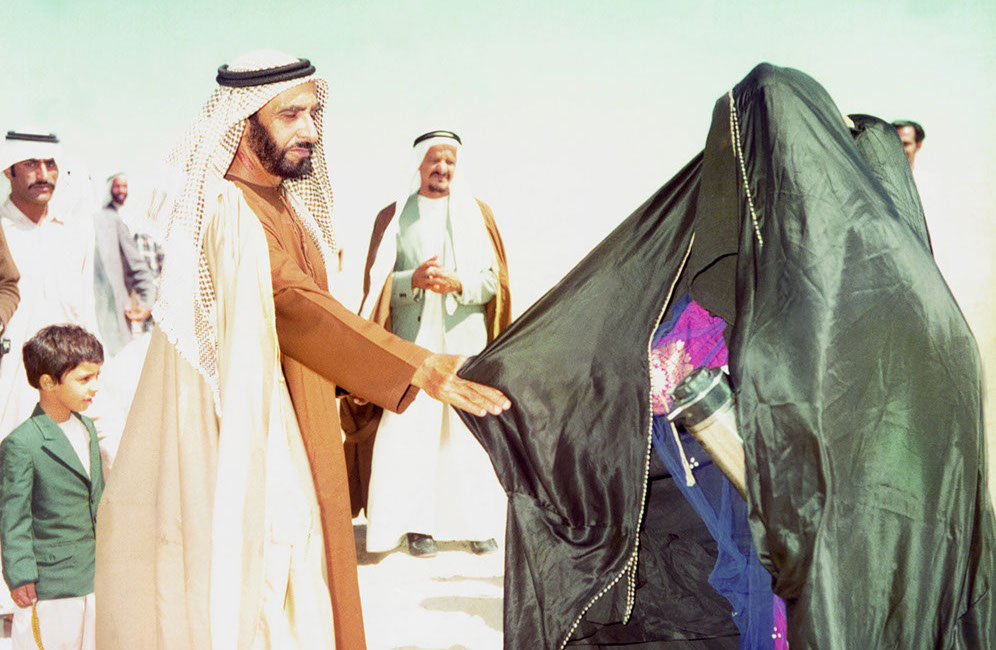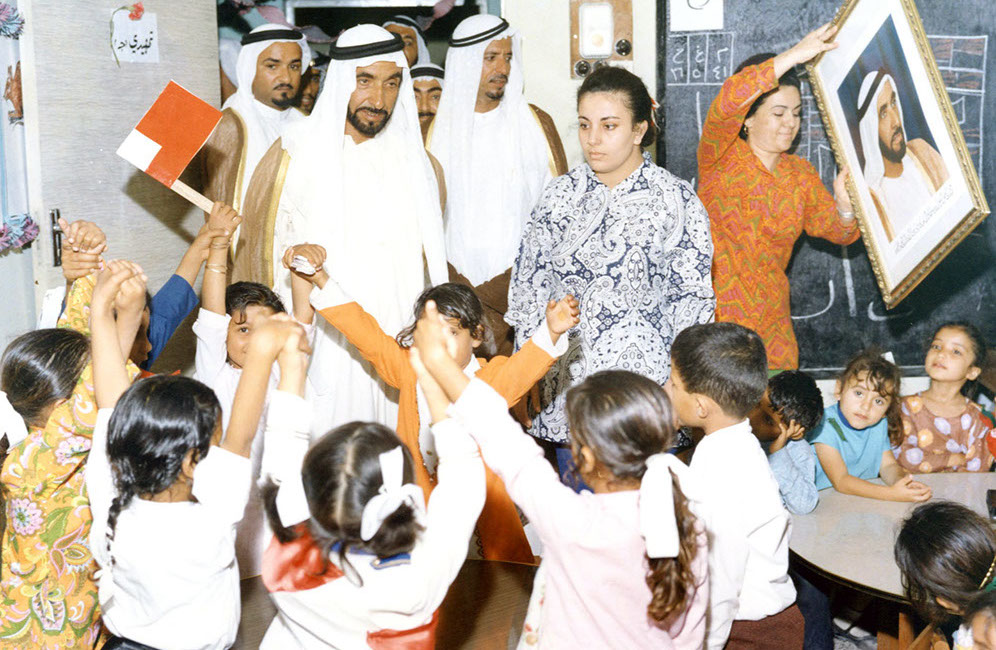
Achievements of Sheikh Zayed bin Sultan
Al Nahyan
Formation of the Union

Sheikh Zayed initiated the union of the UAE Federation. With a forward-thinking vision, he realised that co-operation with other emirates was needed for Abu Dhabi to achieve prosperity. The initial step was meeting Sheikh Rashid bin Saeed Al Maktoum, the Ruler of Dubai at that time. He then held continuous meetings and consultations with the Rulers of different emirates. Ultimately, on 2 December 1971, the UAE was formed, consisting of six emirates – Abu Dhabi, Ajman, Dubai, Fujairah, Sharjah and Umm Al Quwain. On 11 February 1972, Ras Al Khaimah joined the Union officially.
Development and Construction Projects

During Sheikh Zayed’s leadership, numerous developmental, services and construction projects were implemented that significantly transformed the UAE in its entirety. In Abu Dhabi alone, more than AED 162 billion was allocated for these projects from 1968 to 2002. These included the construction of homes, healthcare infrastructure, educational institutions, roads and bridges, as well as transport, communication, electricity and water facilities. These initiatives became instrumental in realising Sheikh Zayed’s vision of building a modern nation and providing a high quality of life for the people of the UAE.
Global Humanitarian Work
Sheikh Zayed was known for being active in charity and humanitarian circles, both in the UAE and internationally. With his mandates, the UAE had provided aid amounting to more than AED 98 billion until the latter part of 2000, in the form of grants, loans and financial assistance. Through his governance, the UAE became globally acclaimed as a country at the forefront of giving foreign assistance, apart from ensuring the welfare of its citizens.
Empowerment of Emirati Women

Another great contribution of Sheikh Zayed was the empowerment of women in the economic, political, social and cultural fields. The dynamic leader always recognised the contributions of Emirati women and their achievements in different sectors. It was also one of his commitments to provide them with equal opportunities and offer them the needed support to further uplift their status, enhance their capabilities, allow them to excel in their chosen fields and strengthen their role in society, ultimately having a positive impact on the country’s development.
Investment in People

Sheikh Zayed believed that true wealth could not be achieved solely through the acquisition of material riches. He put his trust in his own people and invested in their talents and abilities. He pledged to improve the living standards of Emiratis and enhance their economic and social standing, in turn, enabling them to build a great future for the UAE. He used all available resources from oil revenue to run major developmental projects and to establish numerous initiatives that helped build better lives and strengthen a magnificent nation.
Birth of the founding leader

Sheikh Zayed was born in Al Hosn palace in 1918, to Sheikh Sultan bin Zayed. He was named after his famous grandfather, known as Zayed the Great, who ruled Abu Dhabi from 1885 till 1909.Sheikh Zayed’s personality was formed at an early stage living in Al Ain city, where he gained exceptional personal character, leadership and political qualities among the valleys and dunes.
Ruler of Al Ain

In 1946, Sheikh Shakhbout bin Sultan Al Nahyan assigned his brother, Sheikh Zayed as Al Ain Ruler and Ruler’s representative in the Eastern Region. Sheikh Zayed was able to end conflicts between Bedouin tribes in Al Ain, leading to further love and respect from the people living there.
Sheikh Zayed opened his majlis in Al Jahili Fort in Al Ain to welcome citizens to learn more about their problems and give financial support for those in need.
Demarcation of boundaries for Abu Dhabi

When Sheikh Shakhbout realised Sheikh Zayed’s political, diplomatic and negotiations skills, Sheikh Zayed was assigned to accomplish the demarcation of Abu Dhabi’s borders. This was a sign that Sheikh Shakhbut trusted Sheikh Zayed’s wisdom and composure and he knew that Sheikh Zayed could pass any obstacles to accomplish his mission in a peaceful manner. Sheikh Zayed accomplished this mission successfully, through a number of treaties between Abu Dhabi and the neighbouring Emirates.
Abu Dhabi Ruler and the Founder of the Federation

Sheikh Zayed assumed power in Abu Dhabi on 6 August 1966, which is considered as an auspicious occasion that marks the beginning of the development and the prosperity of the UAE.
Sheikh Zayed assumed power as the Ruler of Abu Dhabi, at the same time when Britain announced the withdrawal of all its military forces from the Gulf. Sheikh Zayed realised the importance of filling the political and military vacuum in the area that would result from this withdrawal. He was convinced that a strong union between the Trucial States could protect it, so he used diplomacy to convince the leaders of the importance of the union.
The Trucial States Development Fund

Sheikh Zayed translated his thoughts and principles about the union and exchanging support between the Trucial States into action, by allocating a large amount of Abu Dhabi’s income from oil to support the Trucial States Development Fund, even before the beginning of the union negotiations.
The Union negotiations

After their historical meeting at Al Semha, Sheikh Zayed bin Sultan Al Nahyan and Sheikh Rashid bin Saeed Al Maktoum, announced a federation between the two Emirates. This federation was the first step towards establishing the United Arab Emirates. The two wise rulers agreed on the importance of the union for the country and its citizens' prosperous, after the British withdrawal from the Gulf, and to protect the potentially oil rich coast from the ambitions of powerful neighbours.
Politics & wisdom

Sheikh Zayed’s political ingenuity was reflected clearly in the formation of the UAE. It was obvious, when he insisted on joining the League of Arab States and the United Nations, within a few days after announcing the union. This was an affirmation of the seriousness of the union and its commitment to become a vital part of the international community.
The beginnings of UAE diplomacy

Sheikh Zayed led the newly formed UAE by enhancing its position on the world’s map. Even before the official announcement of the union, he invited Emiratis who held university degrees to a meeting at the headquarters of the Federal Government in Sharjah. Some were chosen to attend an intensive training in diplomacy, to qualify them to hold various positions in UAE’s embassies. Sheikh Zayed ordered the establishment of four embassies and a diplomatic delegation to the United Nations. He wanted these embassies to contribute in enhancing his intensive diplomatic efforts, to stabilise the country’s international position as a strong and independent state.
Union hero and development leader

Sheikh Zayed led a massive development process. The wise leader started construction and development projects all over the country, revamped the education system to enhance the UAE’s steps towards progress, development, and prosperity, which ensured the whole country, blossomed under the leadership of a rare, great, and generous leader.
The Unification of the Armed Forces

After announcing the union, Sheikh Zayed unified the Emirates’ armies, under one flag and one leadership, to strengthen, defend and protect the new country, and ensure peace and security. On 6th of May 1976, the UAE announced the launching of the UAE Armed Forces, under one leadership and one flag. This announcement gave a powerful impetus to strengthen the union, and gave the newly formed country the political importance it was dreaming to achieve.





